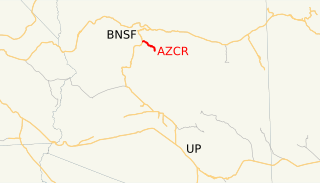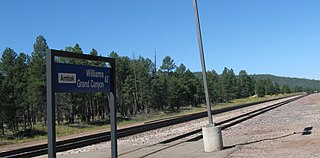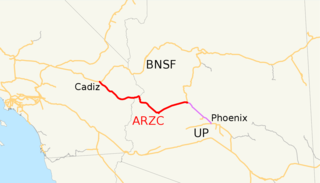
Ash Fork is a census-designated place in Yavapai County, Arizona, United States. Its population was 396 at the 2010 U.S. Census, down from 457 in 2000.

BNSF Railway is the largest freight railroad in the United States. One of six North American Class I railroads, BNSF has 36,000 employees, 33,400 miles (53,800 km) of track in 28 states, and over 8,000 locomotives. It has three transcontinental routes that provide rail connections between the western and eastern United States. BNSF trains traveled over 169 million miles in 2010, more than any other North American railroad.

The BNSF Line is a Metra commuter rail line operated by the BNSF Railway in Chicago and its western suburbs, running from Chicago Union Station to Aurora, Illinois. In 2010, the BNSF Line continued to have the highest weekday ridership of the 11 Metra lines. While Metra does not refer to its lines by particular colors, the BNSF line's color on Metra timetables is "Cascade Green," in honor of the Burlington Northern Railroad.

The Verde Canyon Railroad is a heritage railroad running between Clarkdale and Perkinsville in the U.S. state of Arizona. The passenger excursion line operates on 20 miles (32 km) of tracks of the Clarkdale Arizona Central Railroad (AZCR), a shortline. The Verde Canyon Railroad has its depot, headquarters, and a railway museum in Clarkdale, about 25 miles (40 km) southwest of Sedona.
The California, Arizona and Santa Fe Railway was a non-operating subsidiary of Atchison, Topeka and Santa Fe Railway (ATSF). It was incorporated in 1911, and was merged into the ATSF in 1963.

The Clarkdale Arizona Central Railroad is an Arizona short-line railroad that operates from a connection with the BNSF Railway at Drake, Arizona. The AZCR runs 37.8 miles (60.8 km) from Drake to Clarkdale, Arizona. An excursion train also runs on the line through Verde Canyon and is operated by the same owners under the Verde Canyon Railroad. The AZCR is owned by David L. Durbano.

The Santa Fe, Prescott and Phoenix Railway (SFP&P) was a common carrier railroad that later became an operating subsidiary of the Atchison, Topeka and Santa Fe Railway in Arizona. At Ash Fork, Arizona, the SFP&P connected with Santa Fe's operating subsidiary, the Atlantic & Pacific Railroad mainline, that ran from California to Chicago. The SFP&P's 195-mile (314 km) line extended the Santa Fe Railway south into Phoenix. The SFP&P extended another 100 miles (160 km) to the east from Phoenix to Florence and Winkelman via the Phoenix and Eastern Railroad. The SFP&P also served several mines in the Prescott area, including the Derby Mine by way of the Summit (flag) Station at 'Prieta' in the Sierra Prieta range, through its various subsidiary railroads.

U.S. Route 66 also known as the Will Rogers Highway, was a major United States Numbered Highway in the state of Arizona from November 11, 1926, to June 26, 1985. US 66 covered a total of 385.20 miles (619.92 km) through Arizona. The highway ran from west to east, starting in Needles, California, through Kingman and Seligman to the New Mexico state line. Nationally, US 66 ran from Santa Monica, California, to Chicago, Illinois. In its height of popularity, US 66 was one of the most popular highways in the state of Arizona, sometimes carrying over one million cars a year.

Santa Fe Depot in San Diego, California, is a union station built by the Atchison, Topeka and Santa Fe Railway to replace the small Victorian-style structure erected in 1887 for the California Southern Railroad Company. The Spanish Colonial Revival style station is listed on the National Register of Historic Places and is a San Diego Historic Landmark. Its architecture, particularly the signature twin domes, is often echoed in the design of modern buildings in Downtown San Diego.

Williams Junction was an Amtrak train station on the Southwest Chief route, located three miles (4.8 km) southeast of Williams, Arizona in the Kaibab National Forest. The station primarily served passengers travelling to the Grand Canyon via the Grand Canyon Railway.

Williams Depot is a privately owned train station in Williams, Arizona. It is the southern terminus of the Grand Canyon Railway line.

The Puget Sound and Pacific Railroad operates over 150 miles of track serving the U.S. State of Washington, and is headquartered in Centralia, Washington where interchanges with the BNSF Railway and Union Pacific Railroad are made.

Interstate 40 (I-40) is an east–west Interstate Highway that has a 359.11-mile (577.93 km) section in the US state of Arizona, connecting sections in California and New Mexico. The Interstate is also referred to as the Purple Heart Trail to honor those wounded in combat who have received the Purple Heart. It enters Arizona from the west at a crossing of the Colorado River southwest of Kingman. It travels eastward across the northern portion of the state, connecting the cities of Kingman, Ash Fork, Williams, Flagstaff, Winslow, and Holbrook. I-40 continues into New Mexico, heading to Albuquerque. The highway has major junctions with U.S. Route 93 in Kingman and again approximately 22 miles (35 km) to the east and I-17 in Flagstaff.

The Southern Transcon is a main line of BNSF Railway comprising 11 subdivisions between Southern California and Chicago, Illinois. Completed in its current alignment in 1908 by the Atchison, Topeka and Santa Fe Railway, when it opened the Belen Cutoff in New Mexico and bypassed the steep grades of Raton Pass, it now serves as a mostly double-tracked intermodal corridor.

The Arizona and California Railroad is a class III short line railroad that was a subdivision of the Atchison, Topeka and Santa Fe Railway (ATSF). The ARZC began operations on May 9, 1991, when David Parkinson of the ParkSierra RailGroup purchased the line from the Santa Fe Railway. ParkSierra Railgroup was purchased in January 2002 by shortline railroad holding company RailAmerica. The Genesee & Wyoming shortline railroad holding company purchased RailAmerica in December 2012. ARZC's main commodities are petroleum gas, steel, and lumber; the railroad hauls around 12,000 carloads per year.

Ash Fork Station is a former railway station of the Atchison, Topeka and Santa Fe Railway, located in Ash Fork, Yavapai County, Arizona. The large and 'grand' Harvey House Escalante Hotel and restaurant were part of the station complex.

The United Verde and Pacific Railway was a 3 ft narrow gauge railroad that operated from 1895 to 1920 in what became Yavapai County in the U.S. state of Arizona. William A. Clark built the 26-mile (42 km) line to link his copper mine and smelter in Jerome to an existing branch of the Santa Fe Railway system. Clark eventually replaced the line with three 4 ft 8+1⁄2 instandard gauge rail lines after building a new smelter and company town in Clarkdale.
There have been various proposals to bring commuter rail service to the Phoenix metropolitan area since at least the 1980s. A 2008 government plan, updated in 2018, proposes four lines running at 30-minute headways during peak hours and 2-hour headways during off-peak hours.
The Hassayampa Flyer, also known as the Hassayampa Chief, was a passenger train operated by the Atchison, Topeka and Santa Fe Railway between Ash Fork and Phoenix in Arizona, United States.
The Phoenix Subdivision is a railroad line in the U.S. state of Arizona owned by the Union Pacific Railroad. The southeast end of the line connects to the Gila Subdivision near Eloy, runs northeast to Phoenix, and becomes the Roll Industrial Lead, running southwest before reconnecting to the Gila Subdivision at Wellton. As of 2010, eighty miles (130 km) of the line between Roll and Arlington are out of service and used for car storage.
















